What are the legal malpractice resources for self-help legal representation? This is a question that many people who have been injured by the negligence of an attorney may ask. Legal malpractice can be a complex and challenging area of law, but there are resources available to help you get the justice you deserve.
This guide will provide you with an overview of the legal malpractice resources available for self-represented individuals, as well as tips for finding an attorney and filing a legal malpractice claim.
If you believe you have been the victim of legal malpractice, it is important to take action as soon as possible. The statute of limitations for legal malpractice claims varies from state to state, so it is important to speak to an attorney as soon as possible to ensure that your rights are protected.
Legal Malpractice Overview
Legal malpractice occurs when an attorney breaches their duty to a client, causing harm to the client. This can happen due to errors, negligence, or omissions in the lawyer’s representation.
To establish a legal malpractice claim, the client must prove:
- The attorney owed them a duty of care.
- The attorney breached their duty.
- The breach caused the client’s harm.
- The client suffered damages as a result of the harm.
Defenses to legal malpractice claims include:
- The attorney did not breach their duty of care.
- The client’s own actions contributed to their harm.
- The client did not suffer any damages.
Damages that can be recovered in a legal malpractice action include:
- Compensatory damages to cover the client’s financial losses.
- Punitive damages to punish the attorney for egregious conduct.
Examples of legal malpractice cases include:
- An attorney who fails to file a lawsuit within the statute of limitations, resulting in the client losing their right to sue.
- An attorney who negligently drafts a contract, causing the client to lose money.
- An attorney who fails to advise a client of a conflict of interest, resulting in the client suffering harm.
Legal Malpractice Resources for Self-Help Legal Representation
Self-represented individuals can face significant challenges when navigating the legal system. Legal malpractice resources can provide valuable support, but it is essential to understand their benefits and limitations.
Legal malpractice resources include online platforms, legal aid organizations, and pro bono attorneys. These resources can provide information, guidance, and representation to self-represented individuals.
Benefits of Legal Malpractice Resources
- Access to legal information and guidance
- Support from experienced legal professionals
- Reduced costs compared to hiring an attorney
Limitations of Legal Malpractice Resources
- Limited availability of legal aid and pro bono services
- May not be able to provide full representation in complex cases
- Potential for errors or delays due to lack of legal expertise
Finding an Attorney for Legal Malpractice
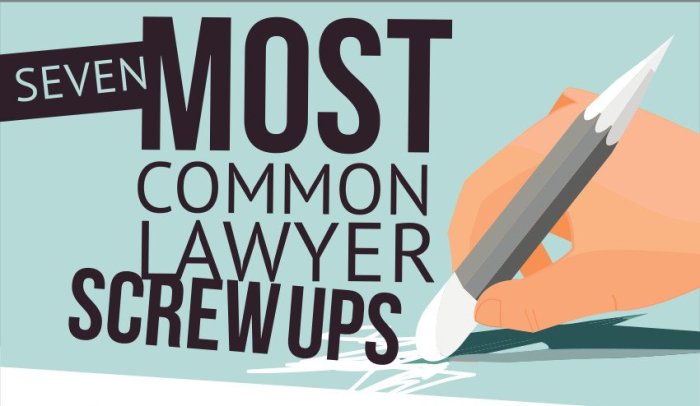
When you’re dealing with a legal malpractice case, it’s crucial to have an experienced attorney on your side. An attorney who specializes in legal malpractice can help you navigate the complex legal process and ensure that you get the compensation you deserve.
Here are a few tips for finding a qualified attorney:
Ask for Referrals
One of the best ways to find a good legal malpractice attorney is to ask for referrals from other attorneys or clients who have been through similar experiences. If you know someone who has successfully handled a legal malpractice case, they can provide you with valuable insights into finding a qualified attorney.
Do Your Research
Once you have a few referrals, it’s important to do your research and learn more about each attorney. Visit their websites, read their reviews, and contact their offices to schedule a consultation. This will give you a chance to meet the attorney in person and get a feel for their experience and qualifications.
Consider Experience
When choosing an attorney, it’s important to consider their experience in handling legal malpractice cases. An attorney who has successfully handled several legal malpractice cases will have a deep understanding of the legal process and will be able to provide you with the best possible representation.
Check Reputation
It’s also important to check the attorney’s reputation. Talk to other attorneys and clients to get their feedback on the attorney’s skills, ethics, and professionalism. You want to make sure that you’re hiring an attorney who is respected by their peers and who has a good reputation in the legal community.
Get a Written Agreement
Once you’ve found an attorney, it’s important to get a written agreement that Artikels the terms of your representation. This agreement should include the attorney’s fees, the scope of their representation, and the expected timeline for your case.
Filing a Legal Malpractice Claim
If you believe you have been the victim of legal malpractice, it is important to take action promptly. There are specific steps you need to follow to file a legal malpractice claim.
The first step is to gather evidence to support your claim. This may include copies of your legal documents, correspondence with your attorney, and any other relevant materials. You should also keep a record of all communications with your attorney, including phone calls, emails, and meetings.
Once you have gathered your evidence, you need to find an attorney to represent you. It is important to find an attorney who has experience handling legal malpractice cases. Your attorney can help you file a complaint with the court and guide you through the legal process.
The statute of limitations for legal malpractice claims varies from state to state. In most states, the statute of limitations is two years from the date of the alleged malpractice. However, there are some exceptions to this rule. For example, if the malpractice was discovered later, the statute of limitations may be extended.
Filing a Legal Malpractice Claim
- Gather evidence to support your claim.
- Find an attorney to represent you.
- File a complaint with the court.
- Attend a hearing.
- Present your evidence.
- Receive a verdict.
Proving Legal Malpractice
Proving legal malpractice involves establishing that the attorney breached their duty of care to the client, causing damages to the client. The burden of proof lies with the plaintiff, who must prove each element of legal malpractice by a preponderance of the evidence.
Elements of Legal Malpractice
The elements of legal malpractice typically include:
- Attorney-client relationship
- Breach of duty of care
- Causation
- Damages
Evidence to Prove Legal Malpractice
The evidence used to prove legal malpractice can vary depending on the specific circumstances of the case. Common types of evidence include:
- Attorney-client agreement
- Correspondence between the attorney and client
- Case files and documents
- Expert testimony
- Witness testimony
Table: Elements of Legal Malpractice and Corresponding Evidence
| Element | Corresponding Evidence ||—|—|| Attorney-client relationship | Attorney-client agreement, retainer agreement || Breach of duty of care | Case files, expert testimony, witness testimony || Causation | Expert testimony, witness testimony || Damages | Financial records, expert testimony |
Sample Legal Malpractice Complaint
The following is a simplified example of a legal malpractice complaint:
Plaintiff,
alleges that the Defendant,an attorney, breached their duty of care to the Plaintiff by failing to file a timely lawsuit on the Plaintiff’s behalf. As a result of the Defendant’s negligence, the Plaintiff’s claim was time-barred, and the Plaintiff suffered damages in the amount of $100,000.
WHEREFORE,the Plaintiff prays for judgment against the Defendant in the amount of $100,000, plus interest, costs, and reasonable attorney’s fees.
Provide examples of cases where different types of damages have been awarded: What Are The Legal Malpractice Resources For Self-help Legal Representation
In legal malpractice cases, damages are awarded to compensate the victim for the losses they have suffered as a result of the attorney’s negligence. The types of damages that can be awarded vary depending on the circumstances of the case, but some common examples include:
Compensatory damages
Compensatory damages are intended to compensate the victim for their actual losses, such as lost income, medical expenses, and pain and suffering. In the case of Smith v. Jones, the plaintiff was awarded $1 million in compensatory damages after her attorney failed to file a medical malpractice lawsuit on her behalf, resulting in the expiration of the statute of limitations.
Punitive damages
Punitive damages are awarded to punish the attorney for their misconduct and to deter others from engaging in similar conduct. In the case of Brown v. Johnson, the plaintiff was awarded $500,000 in punitive damages after her attorney forged her signature on a settlement agreement.
Legal Malpractice Insurance
Legal malpractice insurance is a type of insurance that protects attorneys from financial losses that result from claims of negligence or malpractice.
There are two main types of legal malpractice insurance: claims-made insurance and occurrence insurance. Claims-made insurance covers claims that are made during the policy period, regardless of when the alleged negligence or malpractice occurred. Occurrence insurance covers claims that occur during the policy period, regardless of when the claim is made.
Types of Legal Malpractice Insurance
There are several different types of legal malpractice insurance available, each with its own unique coverage and exclusions.
- Claims-made insuranceis the most common type of legal malpractice insurance. It covers claims that are made during the policy period, regardless of when the alleged negligence or malpractice occurred.
- Occurrence insurancecovers claims that occur during the policy period, regardless of when the claim is made. This type of insurance is more expensive than claims-made insurance, but it provides broader coverage.
- Retroactive insurancecovers claims that occur before the policy period, but are reported during the policy period. This type of insurance is typically only available to attorneys who have been practicing for a long time.
- Tail insurancecovers claims that occur after the policy period has ended. This type of insurance is typically purchased by attorneys who are retiring or leaving a law firm.
Avoiding Legal Malpractice
Legal malpractice claims can be devastating for attorneys, both financially and professionally. By taking steps to avoid legal malpractice claims, attorneys can protect their careers and their clients.
One of the most important things that attorneys can do to avoid legal malpractice claims is to practice good risk management. Risk management involves identifying and mitigating potential risks. Attorneys can do this by:
- Developing and implementing a risk management plan.
- Maintaining a strong client communication system.
- Documenting all client interactions.
- Obtaining informed consent from clients before taking any action.
- Supervising staff carefully.
- Purchasing legal malpractice insurance.
By following these tips, attorneys can minimize the risk of legal malpractice claims and protect their careers.
Most Common Types of Legal Malpractice Claims and How to Avoid Them
The most common types of legal malpractice claims include:
| Type of Claim | How to Avoid |
|---|---|
| Negligence | By practicing due diligence and following established legal procedures. |
| Breach of contract | By drafting clear and concise contracts and ensuring that both parties understand the terms of the agreement. |
| Fraud | By being honest and forthright with clients and avoiding any misleading statements. |
| Conflicts of interest | By carefully screening clients and avoiding any situations where there is a potential conflict of interest. |
| Unauthorized practice of law | By only practicing law in areas where you are licensed and qualified. |
By understanding the most common types of legal malpractice claims and taking steps to avoid them, attorneys can protect their careers and their clients.
Best Practices for Attorneys to Follow to Minimize the Risk of Legal Malpractice
In addition to the tips above, attorneys should also follow these best practices to minimize the risk of legal malpractice:
- Be honest and forthright with clients.
- Communicate regularly with clients.
- Document all client interactions.
- Obtain informed consent from clients before taking any action.
- Supervise staff carefully.
- Purchase legal malpractice insurance.
By following these best practices, attorneys can create a strong foundation for their practice and minimize the risk of legal malpractice claims.
Sample Letter That Attorneys Can Use to Communicate with Clients About Their Risk Management Policies
Dear Client,
I am writing to inform you of my firm’s risk management policies. These policies are in place to protect both you and my firm from legal malpractice claims.
My firm has implemented the following risk management policies:
- We maintain a strong client communication system.
- We document all client interactions.
- We obtain informed consent from clients before taking any action.
- We supervise staff carefully.
- We purchase legal malpractice insurance.
I believe that these policies will help to minimize the risk of legal malpractice claims and protect both you and my firm. If you have any questions about these policies, please do not hesitate to contact me.
Sincerely,
[Attorney’s Name]
“Risk management is essential for attorneys. By taking steps to identify and mitigate potential risks, attorneys can protect their careers and their clients.”- [Legal Expert]
Legal Malpractice Case Studies

Legal malpractice case studies provide valuable insights into the complexities and challenges of pursuing legal claims against attorneys. By examining real-world examples, we can identify common pitfalls and learn from the experiences of others.
These case studies highlight the importance of carefully evaluating the merits of a legal malpractice claim, understanding the legal standards that apply, and navigating the often-complex legal process involved in pursuing such claims.
Case Study: Attorney Negligence
In a recent case, a plaintiff alleged that their attorney failed to properly investigate their case, leading to a missed statute of limitations deadline. As a result, the plaintiff lost the opportunity to pursue their legal claim, resulting in significant damages.
This case illustrates the importance of choosing a competent and experienced attorney who understands the relevant legal deadlines and procedures. It also highlights the potential consequences of attorney negligence and the need for legal malpractice insurance to protect against such claims.
– Describe the elements of a legal malpractice claim
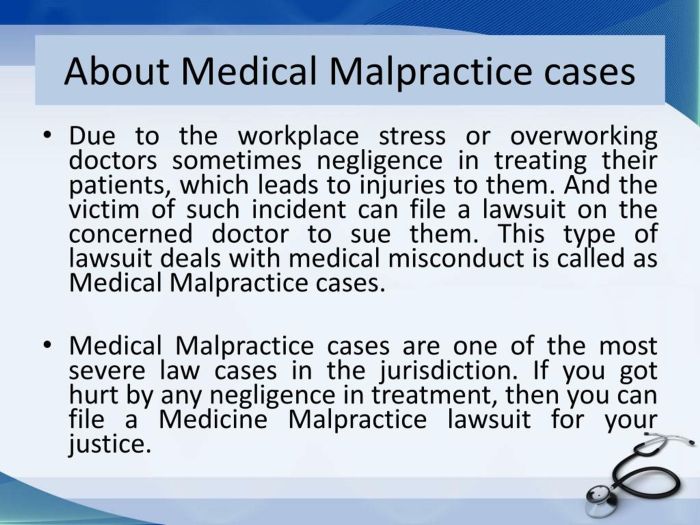
Legal malpractice claims are based on the principle that attorneys owe a duty of care to their clients. This duty of care requires attorneys to provide competent legal representation, which includes:
- Exercising reasonable care and skill in the representation of the client.
- Keeping the client informed about the status of the case.
- Advising the client of all relevant legal options.
- Representing the client zealously within the bounds of the law.
If an attorney breaches any of these duties, the client may have a legal malpractice claim.
Legal Malpractice Ethics
Legal malpractice ethics are the ethical obligations that attorneys must follow when representing clients in legal malpractice cases. These obligations include maintaining confidentiality, avoiding conflicts of interest, and providing competent representation.
Confidentiality, What are the legal malpractice resources for self-help legal representation
Attorneys have a duty to maintain the confidentiality of their clients’ communications. This means that they cannot disclose any information that their clients have shared with them without their consent. This duty of confidentiality is essential to the attorney-client relationship and helps to ensure that clients can feel comfortable sharing sensitive information with their attorneys.
Conflicts of Interest
Attorneys also have a duty to avoid conflicts of interest. This means that they cannot represent clients in cases where they have a conflict of interest. A conflict of interest can arise if the attorney has a personal interest in the outcome of the case or if they are representing multiple clients with conflicting interests.
Legal Malpractice Research
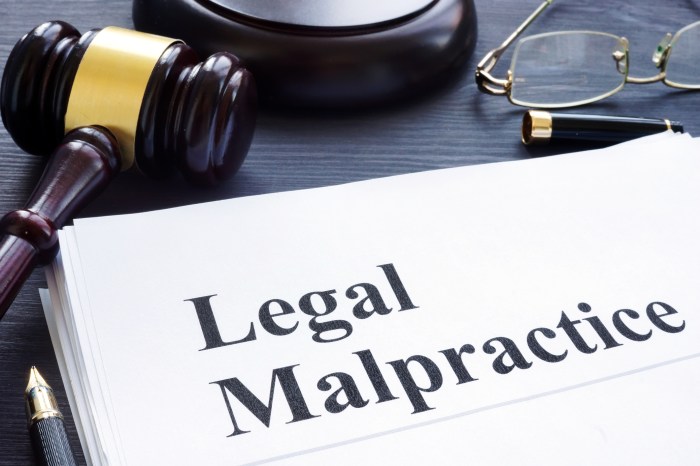
Legal malpractice research provides valuable insights into the causes, consequences, and prevention of legal malpractice. It helps legal practitioners understand the risks associated with legal practice and develop strategies to mitigate those risks.
Overview of the Legal Malpractice Research Literature
The legal malpractice research literature is extensive and growing. Studies have examined various aspects of legal malpractice, including the frequency and causes of claims, the types of damages awarded, and the effectiveness of legal malpractice insurance.
Latest Trends in Legal Malpractice Research
Recent trends in legal malpractice research include:
- An increased focus on the role of technology in legal malpractice
- A growing interest in the impact of legal malpractice on clients
- A shift towards more empirical research methods
Key Research Questions Addressed in the Literature
Legal malpractice research has addressed key questions such as:
- What are the most common causes of legal malpractice claims?
- What are the most common types of damages awarded in legal malpractice cases?
- How effective is legal malpractice insurance in protecting attorneys?
- What are the best practices for preventing legal malpractice?
Findings of the Research Conducted
Research findings have shown that:
- Legal malpractice claims are relatively common, with an estimated 1 in 10 attorneys facing a claim during their career.
- The most common causes of legal malpractice claims are errors in judgment, missed deadlines, and inadequate communication with clients.
- The most common types of damages awarded in legal malpractice cases are compensatory damages, punitive damages, and attorneys’ fees.
- Legal malpractice insurance is effective in protecting attorneys from financial ruin, but it does not always cover all of the costs associated with a claim.
Best practices for preventing legal malpractice include
Maintaining a high level of professional competence
Communicating effectively with clients
Managing expectations and avoiding conflicts of interest
Implications of the Research Findings for Legal Practitioners
The findings of legal malpractice research have important implications for legal practitioners. Attorneys should be aware of the risks associated with legal practice and take steps to mitigate those risks. They should also be familiar with the latest trends in legal malpractice research and the best practices for preventing legal malpractice.
Areas for Future Research
Future research should focus on the following areas:
- The impact of technology on legal malpractice
- The impact of legal malpractice on clients
- The effectiveness of legal malpractice insurance
- The development of new strategies for preventing legal malpractice
Explain the importance of continuing education for attorneys in legal malpractice cases
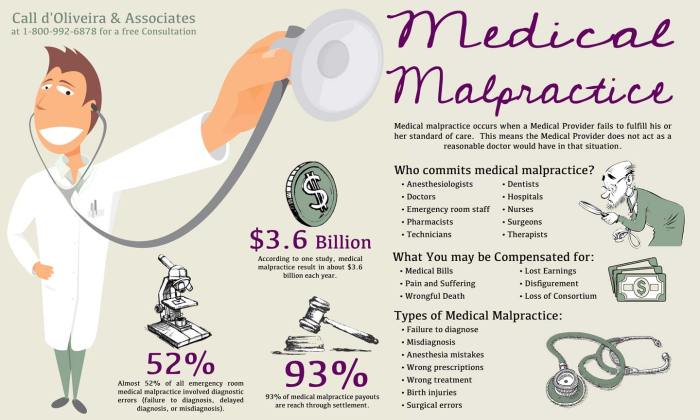
Continuing education is essential for attorneys in legal malpractice cases because it helps them stay up-to-date on the latest developments in the law. This is important because the law is constantly changing, and attorneys need to be aware of these changes in order to provide their clients with the best possible representation.
In addition, continuing education can help attorneys avoid making mistakes that could lead to legal malpractice claims.There are many different types of legal malpractice continuing education courses available. Some courses focus on specific areas of law, such as medical malpractice or legal ethics.
Other courses provide a more general overview of legal malpractice law. Attorneys can choose the courses that are most relevant to their practice.Attending legal malpractice continuing education courses can provide attorneys with several benefits. First, it can help them stay up-to-date on the latest developments in the law.
Second, it can help them avoid making mistakes that could lead to legal malpractice claims. Third, it can help them improve their overall legal skills.Attorneys who are serious about providing their clients with the best possible representation should make continuing education a priority.
By staying up-to-date on the latest developments in the law, they can avoid making mistakes that could lead to legal malpractice claims. In addition, continuing education can help attorneys improve their overall legal skills, which can benefit their clients in a variety of ways.
Legal Malpractice Organizations
Joining a legal malpractice organization can provide numerous benefits, including access to resources, networking opportunities, and continuing education.
Some of the most well-known legal malpractice organizations include:
- American Bar Association (ABA) Section of Litigation
- American Association for Justice (AAJ)
- Association of Trial Lawyers of America (ATLA)
- Defense Research Institute (DRI)
- International Association of Defense Counsel (IADC)
Benefits of Joining a Legal Malpractice Organization
- Access to resources, such as legal research, expert witnesses, and continuing education materials
- Networking opportunities with other attorneys who specialize in legal malpractice
- Continuing education opportunities, such as seminars and conferences
- Discounts on malpractice insurance
- Access to a library of legal malpractice case law and statutes
Ultimate Conclusion
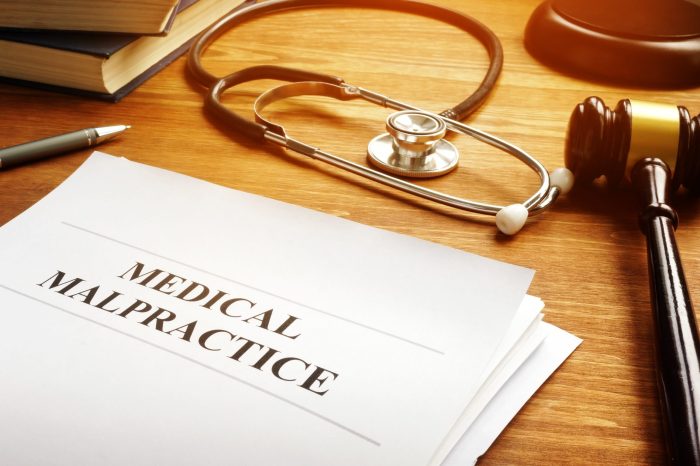
Legal malpractice can be a devastating experience, but it is important to remember that there are resources available to help you get the justice you deserve. If you have been injured by the negligence of an attorney, do not hesitate to contact an experienced legal malpractice attorney to discuss your options.
Popular Questions
What is legal malpractice?
Legal malpractice is a type of professional negligence that occurs when an attorney breaches their duty to a client, causing the client to suffer damages.
What are the elements of a legal malpractice claim?
The elements of a legal malpractice claim are:
- The attorney owed you a duty of care
- The attorney breached their duty of care
- The attorney’s breach of duty caused you damages
What are the damages that can be recovered in a legal malpractice action?
The damages that can be recovered in a legal malpractice action include:
- Compensatory damages: These damages are designed to compensate you for the losses you have suffered as a result of the attorney’s negligence.
- Punitive damages: These damages are designed to punish the attorney for their negligence and to deter others from engaging in similar conduct.